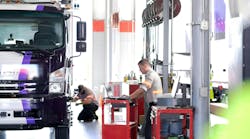JIT, just-in-time inventory management, has shaped the modern trucking industry perhaps more than any other single factor. Since the 1970's, it has spread out of the automotive factories where it was born and into every area of manufacturing and even retail, creating the need for the mobile communications, supply chain integration and synchronized velocity we consider an essential part of doing business. But what if JIT's time has just come and gone?
Think about it. The operating environment in which JIT was conceived was nothing like it is today. Fuel costs were low, serious traffic congestion was still an event-driven rarity and there was abundant freight-carrying capacity and competition. At least in North America, terror was still the stuff of B-level movies. Carriers were not struggling with a driver shortage and manufacturers were not struggling with raw materials shortages, either. There were huge savings to be had by switching away from inventory warehousing to more and smaller deliveries.
Now that world is gone. In its stead, we have record-breaking fuel prices and perhaps even shortages down the road. Traffic congestion has turned many urban-area freeways into slow-moving rivers of cars and trucks, crawling along at a money-loosing pace. There is a freight capacity shortage, too, which is further exacerbated by a serious driver shortage.
Globalization (What was that in the 1970's?) has stretched supply chains out across continents and oceans, and worldwide demand for raw materials and manufactured goods all along those chains is creating shortages here at home and abroad. Terrorism now plucks at those slender supply chains, too, creating the need for more and better security.
Suddenly, as Air Cargo World writer Ian Putzger recently noted, “just in case carries more weight than just in time.” No wonder some suppliers are relocating to be closer to their key customers and national inventory levels are climbing once again, along with investments in warehousing. It's not that JIT has become irrelevant, but that it's loosing its role as the only metronome for manufacturing and freight transportation. The big question now is, what comes next? How do fleets respond to the needs of this new environment?
For starters, it may be helpful to take a fresh look at where the opportunities are now, including for your shippers. Lee Clair of Northbridge, Inc. offered some suggestions at the recent Maddocks Systems User Group Conference in his address, “The New Normal,” including blending and integrating all possible networks and processes and sharing the benefits. He had advice for shippers, too, such as making facilities more driver-friendly, being more flexible and rethinking JIT.
Lane-by-lane and load-by-load, success in today's environment will certainly require intense collaboration between carriers and shippers. It will be all about customization and optimization, whether that means moving to off-hour delivery schedules, setting up warehousing operations, or even parting company with customers unable or unwilling to roll up their sleeves and participate in creating new, win-win solutions.
Fleets now have an opportunity to assume the leadership role, as shippers did back in the heyday of JIT. Carriers have the technology, the information, the infrastructure and even the leverage to help shape the new transportation and logistics world into something better suited to the realities of today, something less about speed and more about intelligence, less Just-In-Time, more Just Intelligent Transportation.


